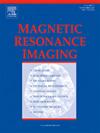用超快DCE-MRI评估乳腺病变:时间分辨率对药代动力学的影响。
IF 2
4区 医学
Q2 RADIOLOGY, NUCLEAR MEDICINE & MEDICAL IMAGING
引用次数: 0
摘要
目的:探讨时间分辨率对乳腺癌药代动力学参数及诊断效能的影响。方法:这项前瞻性研究纳入了89例连续患者的97个病变(76例恶性,21例良性)。在3-T MRI扫描仪上使用caipirhah - dixon - twist - vibe (CDTV)进行超快动态对比增强(UF-DCE)成像,原生时间分辨率为4.5 s /相位。CDTV数据在9.0到58.5 s的不同时间分辨率下采样,创建了8个额外的数据集。采用Tofts模型和基于人群的动脉输入函数(AIF)计算药代动力学参数,包括Ktrans、kep和ve。采用Bonferroni校正的配对样本t检验和ROC曲线进行统计分析。结果:随着时间分辨率从4.5 s降低,Ktrans和kep值升高,ve值降低。在4.5 s时间分辨率下,Ktrans、keep和ve的auc分别为0.648、0.778和0.685。在时间分辨率小于18 s的情况下,与4.5 s的参考相比,Ktrans和定量参数的保持偏差小于10 %。任何参数的AUC对之间没有显著差异(校正p > 0.00625)。结论:我们的研究结果显示,基于UF-DCE MRI基于人群的AIF,时间分辨率显著影响药代动力学参数。然而,乳腺癌的诊断能力可能不会受到实质性的影响。为准确计算药代动力学参数,建议时间分辨率小于18 s。本文章由计算机程序翻译,如有差异,请以英文原文为准。
Evaluating breast lesions with ultrafast DCE-MRI: The impact of temporal resolution on pharmacokinetics
Objective
This study aimed to evaluate the impact of temporal resolution on pharmacokinetic parameters and the performance in diagnosing breast cancer.
Methods
This prospective study included 89 consecutive patients with 97 lesions (76 malignant and 21 benign). Ultrafast dynamic contrast-enhanced (UF-DCE) imaging was performed on a 3-T MRI scanner using CAIPIRINHA-Dixon-TWIST-VIBE (CDTV) with a native temporal resolution of 4.5 s per phase. The CDTV data were downsampled at various temporal resolutions ranging from 9.0 to 58.5 s, creating eight additional datasets. Pharmacokinetic parameters, including Ktrans, kep, and ve, were calculated using Tofts model and population-based arterial input function (AIF). Paired-sample t-test with Bonferroni correction and ROC curves were used for statistical analysis.
Results
As temporal resolution decreased from 4.5 s, Ktrans and kep values increased, while ve values decreased. The AUCs of Ktrans, kep, and ve at 4.5-s temporal resolution were 0.648, 0.778, and 0.685, respectively. Temporal resolutions shorter than 18 s showed less than a 10 % deviation in Ktrans and kep of quantitative parameters compared to the 4.5-s reference. No significant difference was noted among AUC pairs for any of the parameters (corrected p > 0.00625).
Conclusions
Our results revealed that the temporal resolution significantly impacted pharmacokinetic parameters based on the population-based AIF from UF-DCE MRI. However, the diagnostic ability to characterize breast cancer might not be substantially affected. A temporal resolution shorter than 18 s is recommended for accurate calculation of pharmacokinetic parameters.
求助全文
通过发布文献求助,成功后即可免费获取论文全文。
去求助
来源期刊

Magnetic resonance imaging
医学-核医学
CiteScore
4.70
自引率
4.00%
发文量
194
审稿时长
83 days
期刊介绍:
Magnetic Resonance Imaging (MRI) is the first international multidisciplinary journal encompassing physical, life, and clinical science investigations as they relate to the development and use of magnetic resonance imaging. MRI is dedicated to both basic research, technological innovation and applications, providing a single forum for communication among radiologists, physicists, chemists, biochemists, biologists, engineers, internists, pathologists, physiologists, computer scientists, and mathematicians.
 求助内容:
求助内容: 应助结果提醒方式:
应助结果提醒方式:


